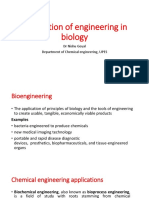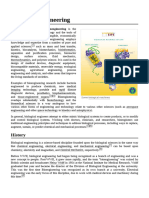0% found this document useful (0 votes)
5 views21 pagesIntroduction
The document discusses the importance of biology in engineering education, highlighting the need for engineers to understand biological principles to contribute to advancements in technology and medicine. It covers various applications of biology in engineering, such as biomechanics, bio-robotics, biopolymers, and bio-sensors, emphasizing their relevance in modern engineering practices. The text advocates for integrating biology into engineering curricula to prepare students for future innovations in biological systems.
Uploaded by
devangbhawan232Copyright
© © All Rights Reserved
We take content rights seriously. If you suspect this is your content, claim it here.
Available Formats
Download as PDF, TXT or read online on Scribd
0% found this document useful (0 votes)
5 views21 pagesIntroduction
The document discusses the importance of biology in engineering education, highlighting the need for engineers to understand biological principles to contribute to advancements in technology and medicine. It covers various applications of biology in engineering, such as biomechanics, bio-robotics, biopolymers, and bio-sensors, emphasizing their relevance in modern engineering practices. The text advocates for integrating biology into engineering curricula to prepare students for future innovations in biological systems.
Uploaded by
devangbhawan232Copyright
© © All Rights Reserved
We take content rights seriously. If you suspect this is your content, claim it here.
Available Formats
Download as PDF, TXT or read online on Scribd
/ 21























































































